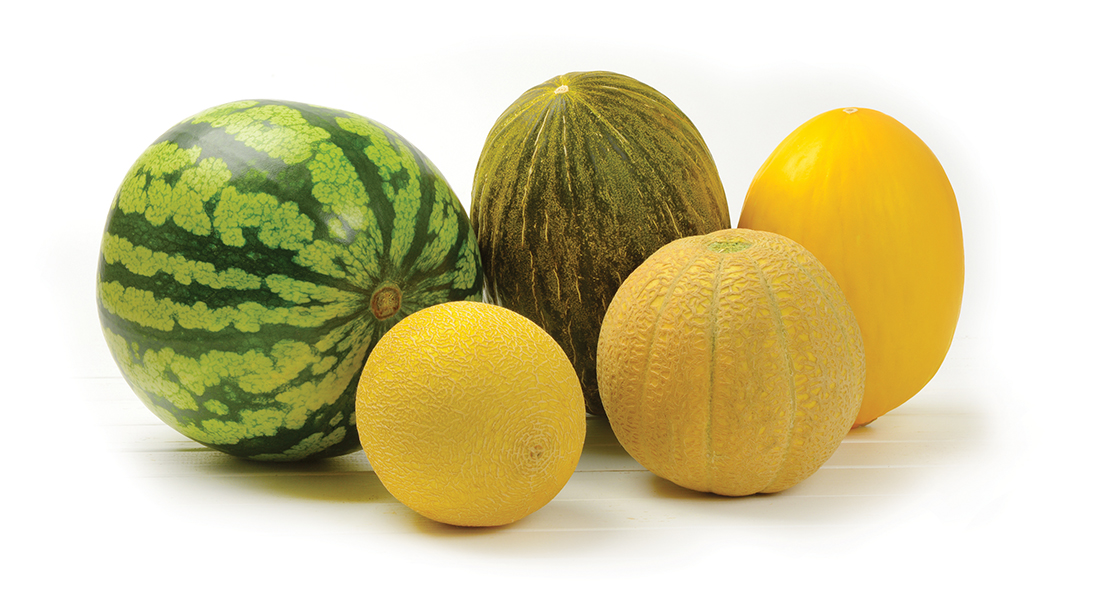
Sandhills Melon
Slice it any way you like
By Jan Leitschuh
When the heat is on, the kitchen is the last place you want to be, unless it’s rummaging in the refrigerator. Luckily for the Sandhills, the melon bonanza of July — starting with the first local watermelons on Independence Day -— continues on through the first few weeks of August. So don’t delay if you haven’t gotten your summer Sandhills melon on.
Sandhills melons are dessert in a rind. Breakfast too. Crisp. Juicy. Cool and sweet. And healthy. What’s not to devour?
On a hot and thirsty day, they are hydrating with their high water content — up to 90 percent, making for a juicy and sweet texture. Blended with a little mint or basil, it’s the ultimate healthy electrolyte sports drink, refreshing after mowing the lawn.
The Sandhills grows melons quite well. Apparently, this viny fruit enjoys our “light land,” that is, the sandy soils, which don’t hold certain nutrients that promote vine growth at the expense of fruit. The sand helps concentrate flavor instead of growing rampant greenery. Wholesale buyers are said to pour in from other areas because of the delectable sweetness of our Sandhills melons.
Melon versatility is another mark in their favor. A simple slice enhances any meal as a colorful and healthy sideshow. Melon can be eaten as dessert in combo with other fruits, or with prosciutto as a light meal. Melon bits can be added to salads, blended into cold summer soups, as fruit slurry added to boozy cocktails, as drinks and juices, as sorbets and granitas. Where does something so tasty get off being healthy? Melons contain folate, niacin, vitamin B6, vitamin A, copper, iron, phosphorus and manganese.
Melons are members of the Cucurbitaceae family, which makes them the sweeter relatives of squashes and juicy cucumbers. Although often grouped together, most sweet melons fall into two broad categories: watermelons and muskmelons. You may have heard folks referring to cantaloupes as muskmelons — all cantaloupes are muskmelons, but not all muskmelons are cantaloupes.
Another benefit of buying local melons comes from the way they are harvested. Not having to ship them long distances, a Sandhills grower can let the melon linger to ripe perfection, at which point it “slips” from the vine. Slip-ripe melon should be eaten within a day or two because they are . . . wait for it . . . ripe. Peak melon here has a flavor that is next to impossible to sample out of season. Dive in! They won’t hold. And slip-ripe Sandhills melons deserve to be eaten at their peak. This is one of the supreme benefits of local food — the taste of a fully mature melon.
Although melons are refreshing when served chilled, refrigeration does diminish their flavor, so serving at room temperature is ideal. Or try grilling them: Cooking concentrates their sugars even further. I have even dried melons in a dehydrator for healthy hiking snacks — you don’t end up with much volume but, wow, what a zing of flavor.
In choosing a good melon, first look at the stem scar. A smooth, hollowed scar indicates that the melon was harvested slip-ripe. If a piece of the stem remains, it may have been harvested too early.
For thinner-skinned melons, press very gently on the bottom of the melon, opposite the stem end. If the skin is easy to depress, the melon is ideal for eating.
That wonderful melon fragrance is another clue. A sweet, musky aroma, produced by enzymes that generate more than 200 different fruit esters, also signals ripeness.
Inspect the outside. Does it have any bruising, cracks, moldy patches or soft spots? If there is, pass it by. You should always inspect the melon’s skin, or rind, before you do anything else, because if there are any imperfections on the outside of the melon, there is likely something wrong with the inside as well.
While you’re inspecting your melon, make sure you pick it up and test how heavy it is. If you notice the melon is larger and heavier than expected, it’s a good melon to choose.
The thump test really is “A Thing.” Take the palm of your hand and tap the melon a few times on its skin. If you notice a sound that is very hollow in nature, your melon has promise.
Some common types you’ll find in area markets and farm stands are:
• Cantaloupes. Common, and the most nutrient-rich of our Sandhills melons. The exterior has a rough “netting” atop its creamy rind. The rich, pale orange flesh has a light and sweet flavor, and it can grow from less than one pound to several pounds in weight. Cantaloupes are high in Vitamin A and numerous antioxidants. These netted melons are easy to digest, contribute to vision and eye health, and have a high beta-carotene content, which is great for knocking out free radicals. A sun-warmed, slip-ripe cantaloupe just begs to be paired with prosciutto. Or blend chunks with frozen mango or orange juice. A splash of Grand Mariner liqueur would not be out of place.
• Honeydews. The green counterpart to cantaloupes, pale green honeydews and peach-colored cantaloupes are often paired together in salads. Honeydews have a higher sugar content than either watermelons or Sandhills cantaloupes. As a honeydew ripens, its rind develops a sticky, velvety feel and turns from green to creamy pale green. The honeydew melon usually grows in a round or oval shape, with a very smooth rind, weighing from a pound to several pounds. Honeydew is popular as a dessert ingredient, but I love to juice it for drinks and frozen ices. Blend chunks of honeydew with mint, lime and a little sweetener, then freeze, beating periodically to reduce the ice crystals. Non-alcoholic honeydew mojitos, practically. Scoop the frozen crystals as snow cones for the kids, or serve as a palette cleanser if you want to go all “Downton Abbey.” Another tangy option is to combine honeydew chunks with lime and basil and do the same. Serve as a sorbet, or add rum, triple sec, tequila or a spirit of choice for a grown-up porch-sittin’ sipper.
• Watermelons. Everybody eats these thick-rind fruits. There are almost 50 varieties of watermelon. They taste similar but vary in size, flesh color (mostly pink or red but also yellow, white and orange), and are seedless or seeded. The most popular red-fleshed varieties are rich in the useful antioxidant lycopene. It carries the highest lycopene per serving of any fruit or vegetable. Watermelon can be sliced and chunked, pickled, candied, fermented, injected with one’s favorite spirits or made into a syrup, and its spit seeds have provided children with amusement for generations. The newer “icebox” varieties are handy if you are not feeding a picnic crowd. They tend to be smaller, and virtually seedless. Still, watermelon takes up room in the fridge, so if you are short on space, cut it into chunks and discard the heavy rind. Fresh watermelon chunked in a spinach salad with feta cheese is a cool summer classic. A ripe watermelon has dull, not shiny, skin, and the lighter colored part of the rind, where the melon rested on the ground, should be yellow or creamy, not green or white. A light tap to the rind should produce a hollow sound.
• Sprite melons. Here is the answer to big melons. This little personal-sized melon is perfect for a small treat. It’s about the size of a baseball or softball. Serve half for breakfast with some berries or a prune in the center. The sprite melon looks like a tiny cantaloupe, complete with a round shape and seeds on the inside. The skin of the sprite melon is ivory in color, and it develops brown markings when it ripens. The flavor is delicious. To me, it has a subtle pear flavor in with its melon-ness. A sprite is up to 35 percent sweeter than any other type of melon, so popular with fruit lovers. This is a true dessert melon.
• Canary melon. Named for its bright yellow rind, that yellow skin is as bright as a canary bird. This oval-shaped melon has a hard skin and a pale flesh, and weighs a pound or three. I’m very fond of canary melons, and grab them whenever I find them. The cream-colored flesh has a mild, sweet, slightly tangy flavor and a texture similar to a pear. Originally from Persia, canary melons pair well with citrus and herbs, such as basil and cilantro, and are good for making sorbets and granitas.
• Korean melon. You might find these small cuties around the Sandhills, although they are not common. Snag one if you see them. Another smaller, personal-sized variety, this little elongated yellow-and-white striped melon is cheerful. Korean melon is smaller than the other melons. It has white color flesh and unique flavor. It’s mildly sweet, juicy and is delicious when eaten in a salad. Its small size is perfect for those just wanting a melon “taste,” but don’t want to deal with a larger melon. The flavor is between a honeydew and a cucumber. In fact, it makes an interesting salad sliced with cucumbers and dressed in balsamic vinegar. The sweetness is lower than other western melon varieties but very juicy — 90 percent water — and refreshing.
• Crenshaw. You can sometimes find these around the Sandhills markets. Again, grab them when you find them, as they probably won’t make a reappearance. It’s a hybrid type of melon with a sweet, juicy salmon-orange flesh. It’s ovoid in shape with greenish-yellow skin. This variety is popular, and pretty in a fruit salad.
The Sandhills melon season is brief but worthy. Grab a slip-ripe melon from a local farmer and enjoy. PS
Jan Leitschuh is a local gardener, avid eater of fresh produce and co-founder of the Sandhills Farm to Table Cooperative.





